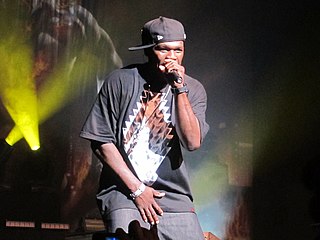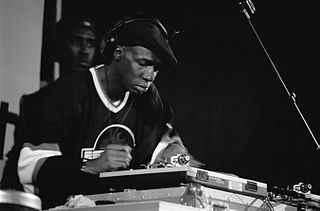Related Research Articles
Belgian hip hop music has a few rappers stemming from Africa and Italy. Belgium, like France, controlled African countries like the Democratic Republic of the Congo, Rwanda, and Burundi until the early 1960s. Like in France, immigrants from these countries started to study and live in Belgium.

Rapping is an artistic form of vocal delivery and emotive expression that incorporates "rhyme, rhythmic speech, and [commonly] street vernacular". It is usually performed over a backing beat or musical accompaniment. The components of rap include "content", "flow", and "delivery". Rap differs from spoken-word poetry in that it is usually performed off-time to musical accompaniment. It also differs from singing, which varies in pitch and does not always include words. Because they do not rely on pitch inflection, some rap artists may play with timbre or other vocal qualities. Rap is a primary ingredient of hip-hop music, and so commonly associated with the genre that it is sometimes called "rap music".
French hip hop or French rap, is the hip hop music style developed in French-speaking countries. France is the second largest hip-hop market in the world after the United States.
The Swiss hip hop culture began in the early 1980s.
West Coast hip-hop is a regional genre of hip-hop music that encompasses any artists or music that originated in the West Coast of the United States. West Coast hip-hop began to dominate from a radio play and sales standpoint during the early to-mid 1990s with the birth of G-funk and the emergence of record labels such as Suge Knight and Dr. Dre's Death Row Records, Ice Cube's Lench Mob Records, the continued success of Eazy-E's Ruthless Records, Dr. Dre's Aftermath Entertainment, and others.
Hip hop music has been popular in Africa since the early 1980s due to widespread African American influence. In 1985, hip hop reached Senegal, a French-speaking country in West Africa. Some of the first Senegalese rappers were Munyaradzi Nhidza Lida, M.C. Solaar, and Positive Black Soul.

"Rapper's Delight" is a 1979 hip hop track that serves as the debut single of American hip-hop trio the Sugarhill Gang, produced by Sylvia Robinson. Although it was shortly preceded by the Fatback Band's "King Tim III ", "Rapper's Delight" is credited for introducing hip hop music to a wide audience, reaching the top 40 in the United States, as well as the top three in the United Kingdom and number one in Canada. It was a prototype for various types of rap music. The track interpolates Chic's "Good Times", resulting in Chic's Nile Rodgers and Bernard Edwards threatening to sue Sugar Hill Records for copyright infringement; a settlement was reached that gave the two songwriting credits. It also interpolates Love De-Luxe's "Here Comes That Sound Again". The track was recorded in a single take. There are five mixes of the song.
Underground hip-hop is an umbrella term for hip hop music that is outside the general commercial canon. It is typically associated with independent artists, signed to independent labels or no label at all. Underground hip hop is often characterized by socially conscious, positive, or anti-commercial lyrics. However, there is no unifying or universal theme – AllMusic suggests that it "has no sonic signifiers". "The Underground" also refers to the community of musicians, fans and others that support non-commercial, or independent music. Music scenes with strong ties to underground hip hop include alternative hip hop and conscious hip hop. Many artists who are considered "underground" today were not always so, and may have previously broken the Billboard charts.

Greatest Hits is a posthumous double-disc greatest hits album by American rapper 2Pac, released by Amaru Entertainment, Death Row Records, Interscope Records, and Jive Records on November 24, 1998.

IAM is a French hip hop band from Marseille. Formed in 1989, it comprises Akhenaton, Shurik'n, Khéops, Imhotep and Kephren. IAM has several meanings, including Invasion Arrivée de Mars. Another meaning is Imperial Asian Man, while AKH often refers to L'homme Impérial Asiatique.

The Canadian hip hop scene was established in the 1980s. Through a variety of factors, it developed much slower than Canada's popular rock music scene, and apart from a short-lived burst of mainstream popularity from 1989 to 1991, it remained largely an underground phenomenon until the early 2000s.

Hip hop or hip-hop is a culture and art movement that was created by African Americans, starting in the Bronx, New York City. Pioneered from Black American street culture, that had been around for years prior to its more mainstream discovery, it later reached other groups such as Latino Americans and Caribbean Americans. Hip-hop culture has historically been shaped and dominated by African American men, though female hip hop artists have contributed to the art form and culture as well. Hip hop culture is characterized by the key elements of rapping, DJing and turntablism, and breakdancing; other elements include graffiti, beatboxing, street entrepreneurship, hip hop language, and hip hop fashion. From hip hop culture emerged a new genre of popular music, hip hop music.
Togo has very diverse and rich traditions in music and dance, which is in part reflected by Togo's regional hip hop scene. Hip-hop togo is the style of Old school hip hop of America mixing with the traditional music of Togo.

Craig Curry, better known by his stage name Craig G, is an American rapper. He is perhaps best known as one of the members of hip hop producer Marley Marl's Cold Chillin' Records group Juice Crew.
European hip hop refers to hip hop music and culture originating from Europe. Emerging in the 1980s following the genre's popularity in the United States, European hip hop has evolved into a diverse and influential musical movement. It encompasses a wide range of styles and subgenres, reflecting the continent's varied cultural landscapes and the experiences of both ethnic nationals and immigrant communities. Notable regional scenes include British hip hop and grime, German hip hop featuring both ethnic German and Turkish artists, and French hip hop, which has undergone several distinct eras of development. Other countries such as the Netherlands, Italy, Poland, and Romania have also produced significant hip hop scenes, each with its own unique characteristics and prominent artists.
Moroccan rap music is a Moroccan musical style related to rap and hip hop culture.
Hip-hop or hip hop, formerly known as disco rap, is a genre of popular music,that emerged in the late 1960s and early 1970s primarily from African American, Afro-Latin, and Afro-Caribbean musical aesthetics practiced by youth in the South Bronx. Hip-hop music originated as an anti-drug and anti-violence social movement led by the Afrika Bambaataa and the Universal Zulu Nation. The genre is characterized by stylized rhythmic sounds—often built around disco grooves, electronic drum beats, and rapping, a percussive vocal delivery of rhymed poetic speech as consciousness-raising expression. The music developed as part of the broader hip-hop culture, a subculture defined by four key stylistic elements: MCing/rapping, DJing/scratching with turntables, breakdancing, and graffiti art or writing. Knowledge is sometimes described as a fifth element, underscoring its role in shaping the values and promoting empowerment and consciousness-raising through music. In 1999, emcee KRS-One, often referred to as "The Teacher," elaborated on this framework in a Harvard lecture, identifying additional elements that extend beyond the basic four. These include self-expression, street fashion, street language, street knowledge, and street entrepreneurialism, which remain integral to hip-hop's musical expression, entertainment business, and sound production. Girls’ double-dutch was also recognized as a key stylistic component of breakdancing, according to KRS. While often used to refer solely to rapping and rap music, "hip-hop" more properly denotes the practice(s) of the entire subculture. The term hip-hop music is sometimes used synonymously with the term rap music, though rapping may not be the focus of hip-hop music. The genre also centers DJing, turntablism, scratching, beatboxing, and instrumental tracks.

The discography of Moroccan-American rapper French Montana consists of five studio albums, twenty-six mixtapes, 51 singles including 57 as featured artist, 32 music videos and 18 promotional singles.
Jewish hip hop is a genre of hip hop music with thematic, stylistic, or cultural ties to Judaism and its musical traditions.
References
- ↑ Bogdanov, Vladimir. All Music Guide to Hip Hop: The Definitive Guide to Rap and Hip Hop. Milwaukee: Backbeat Books, 2003.
- ↑ Mitchell, Tony. "Doin' Damage in my Native Language: The Use of Resistance Vernaculars in Hip Hop in France, Italy, and Aotearoa/New Zealand". Popular Music & Society 24, No. 3 (2000): 41.
- ↑ "Silent Majority". Discogs. Retrieved 3 April 2016.